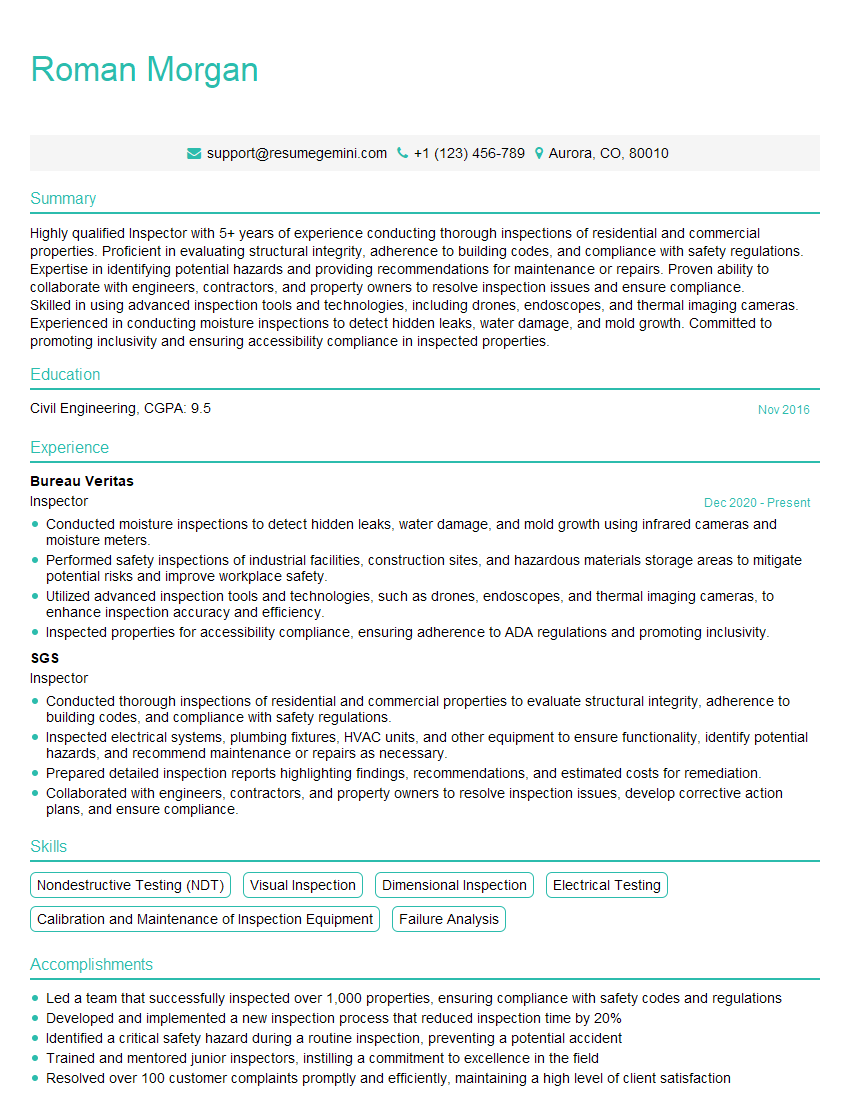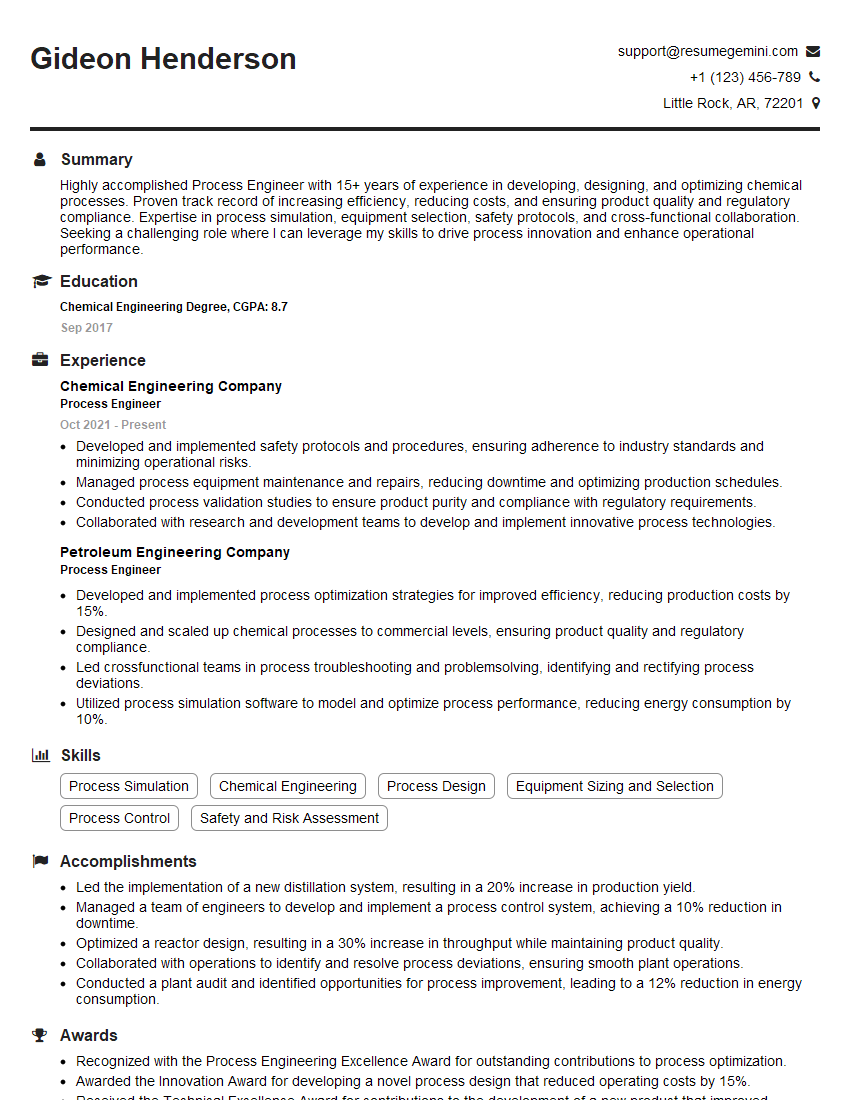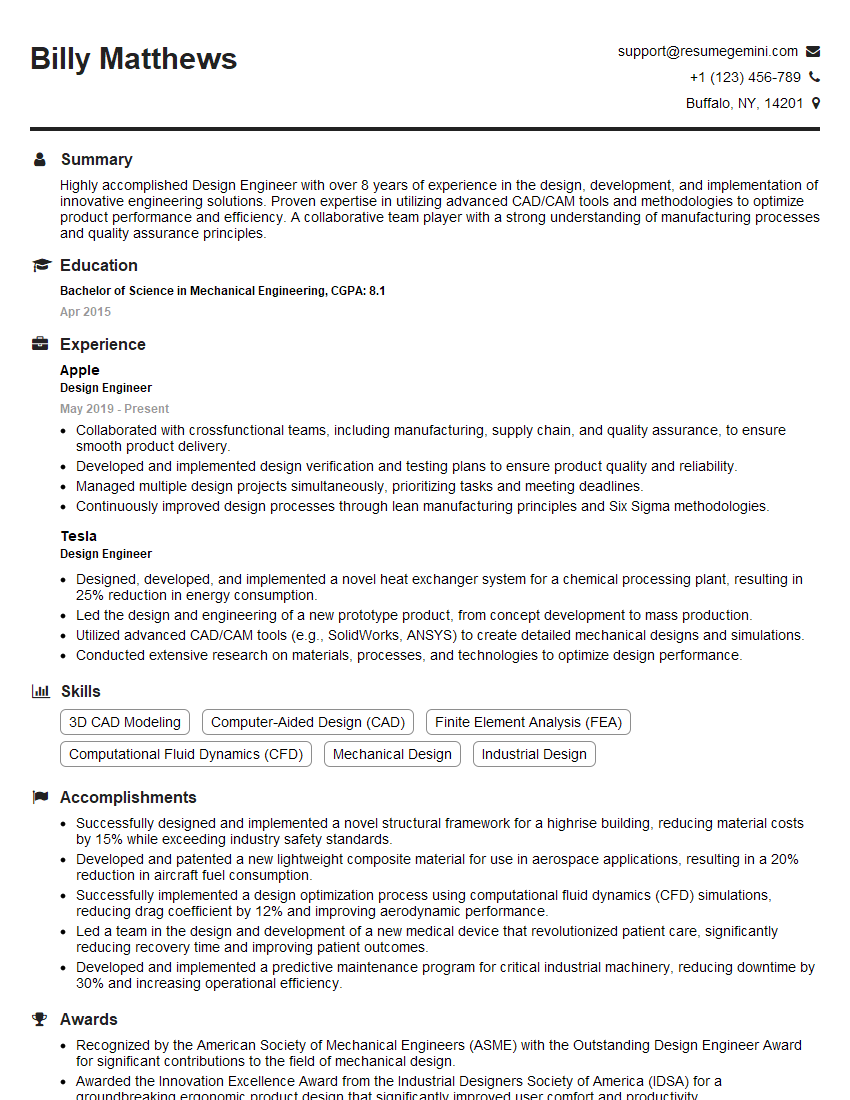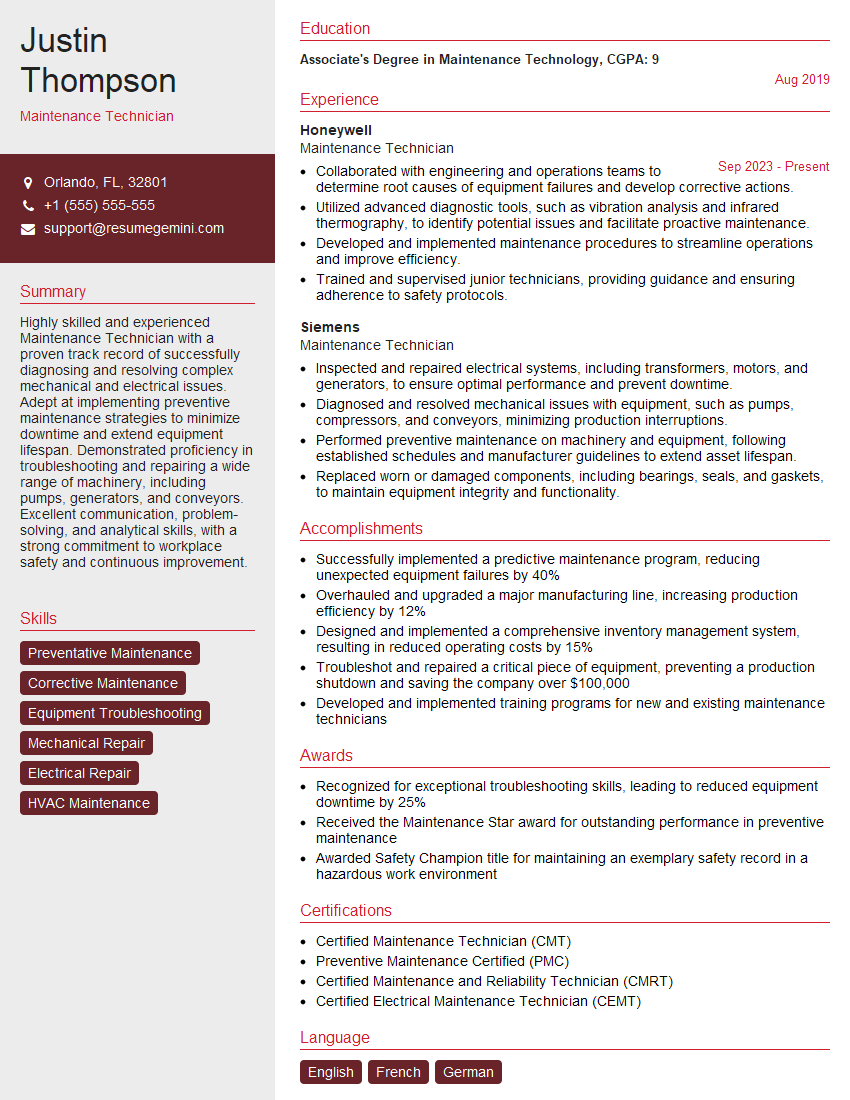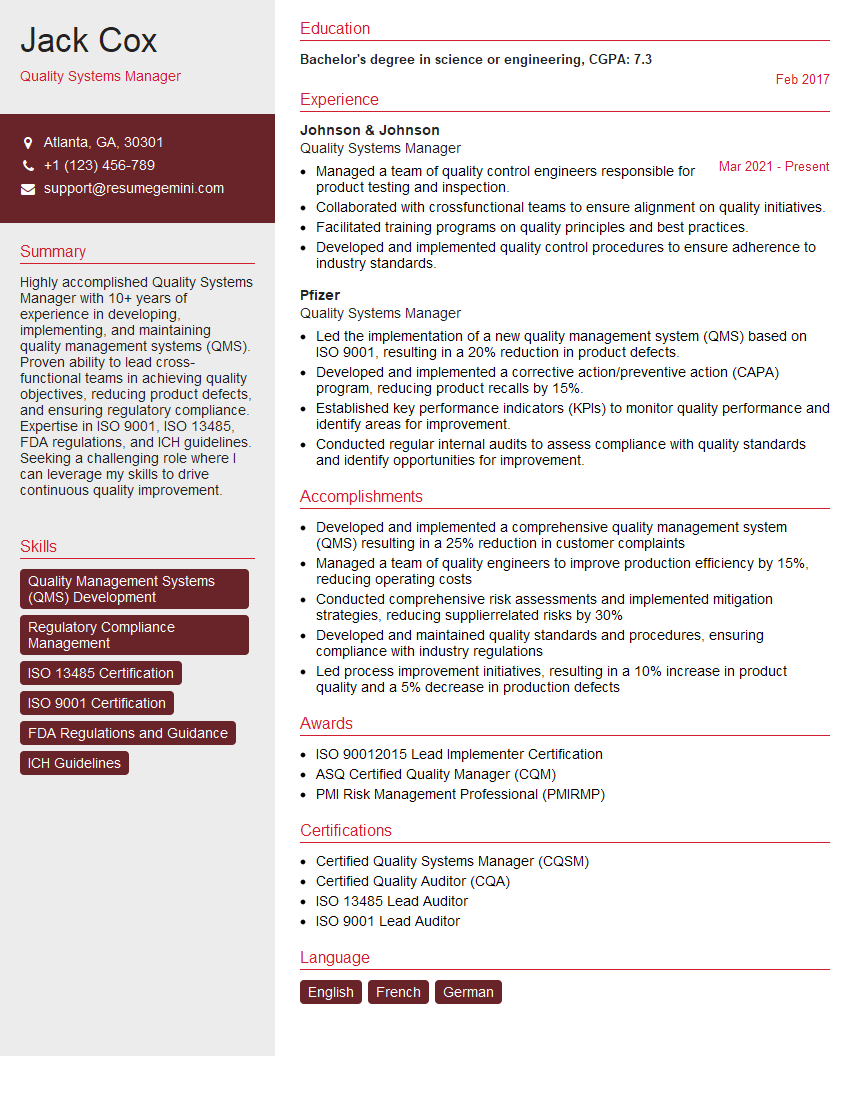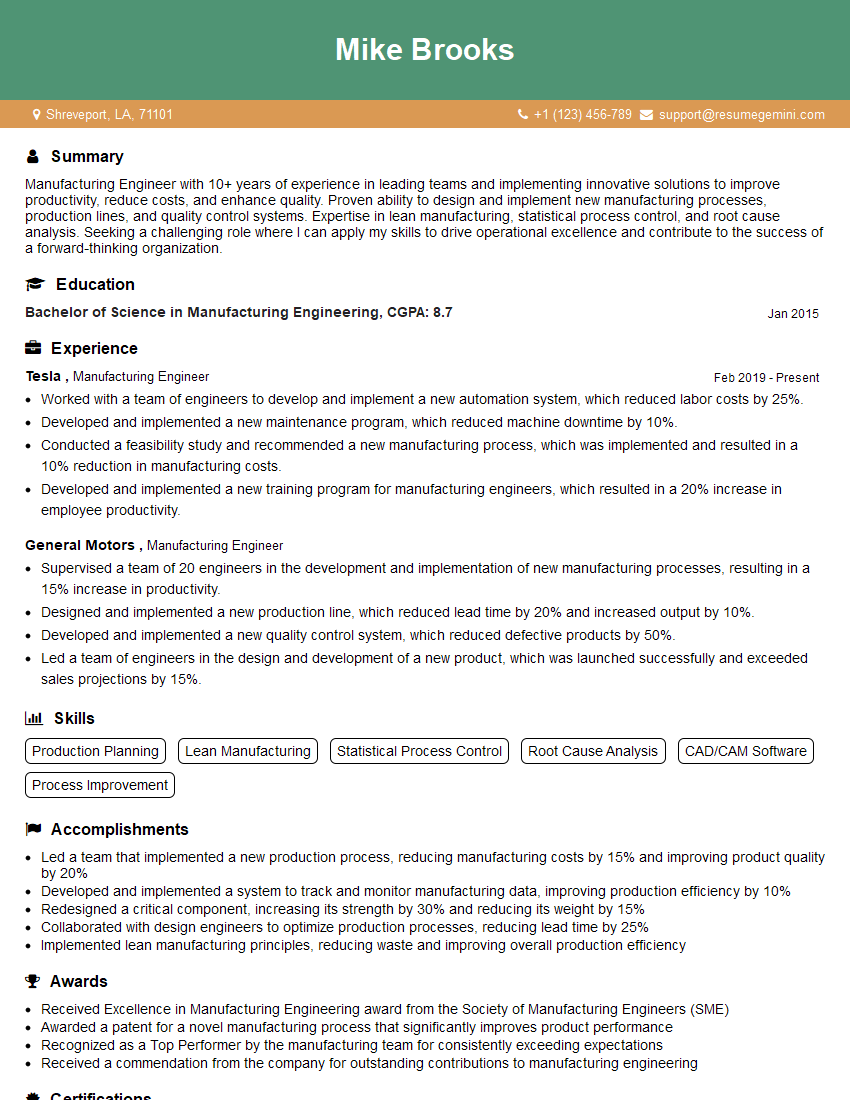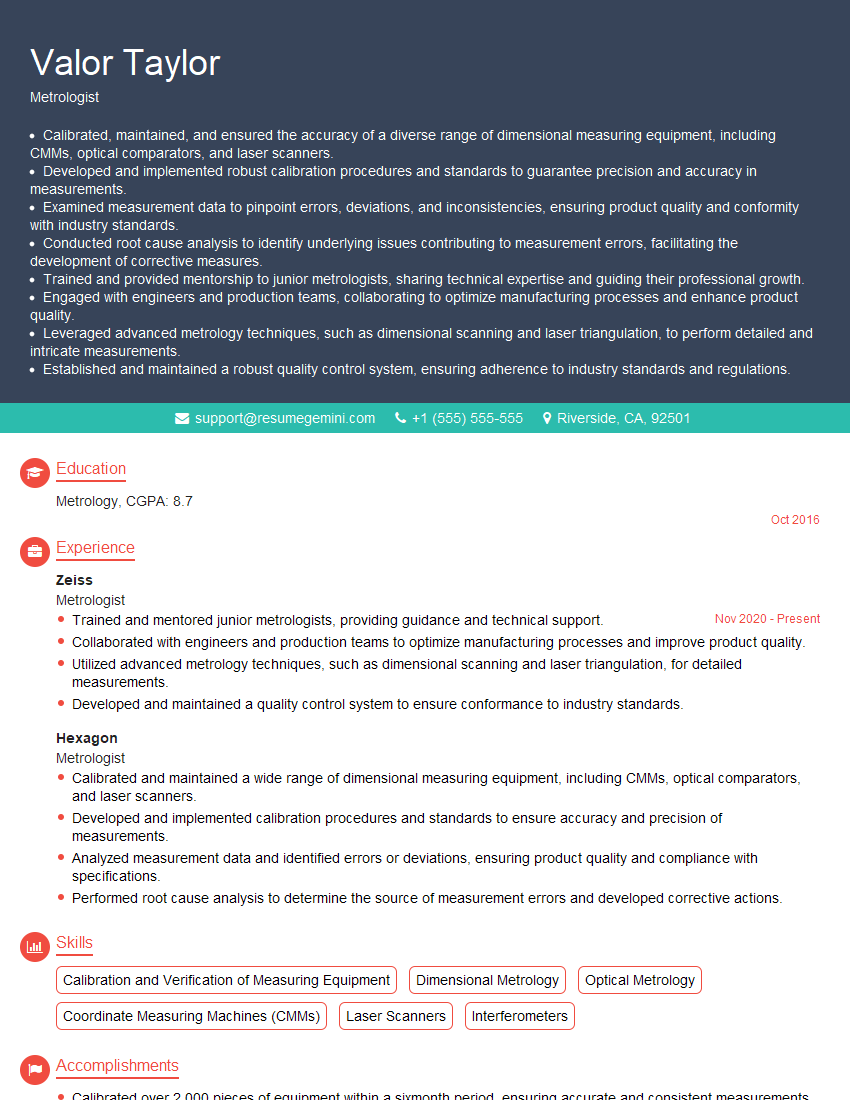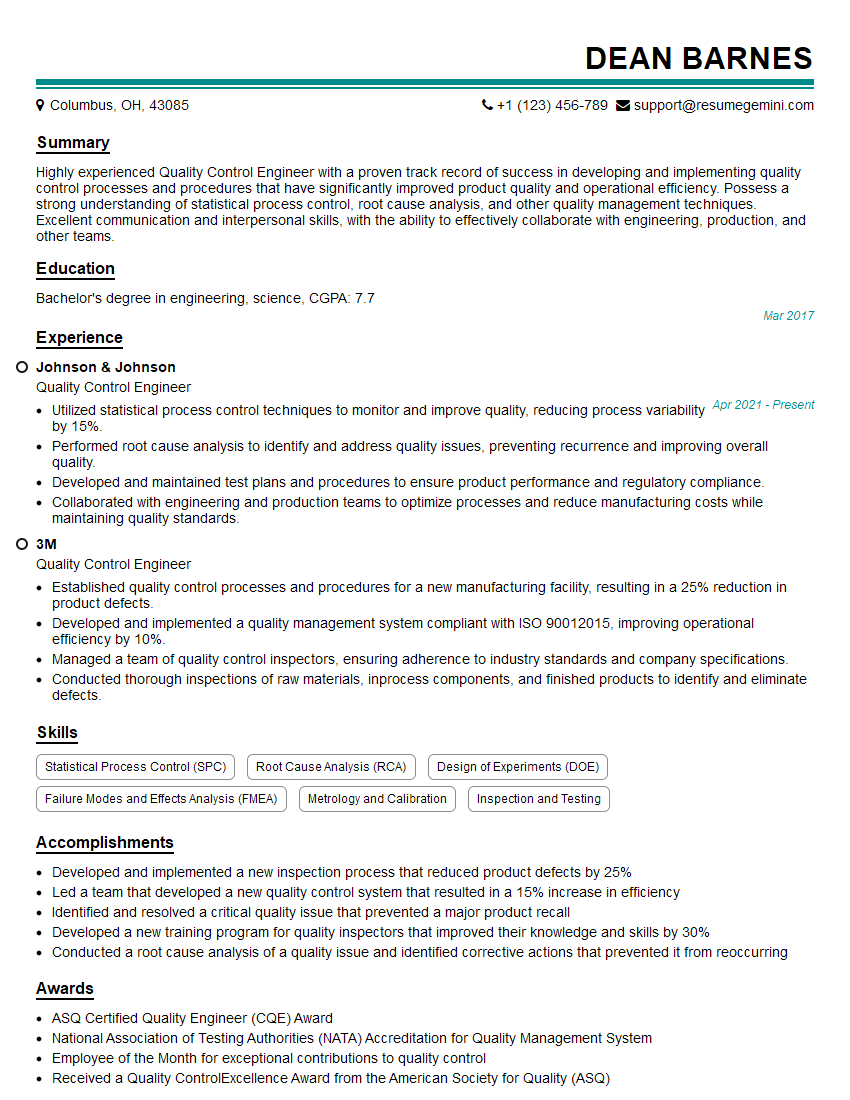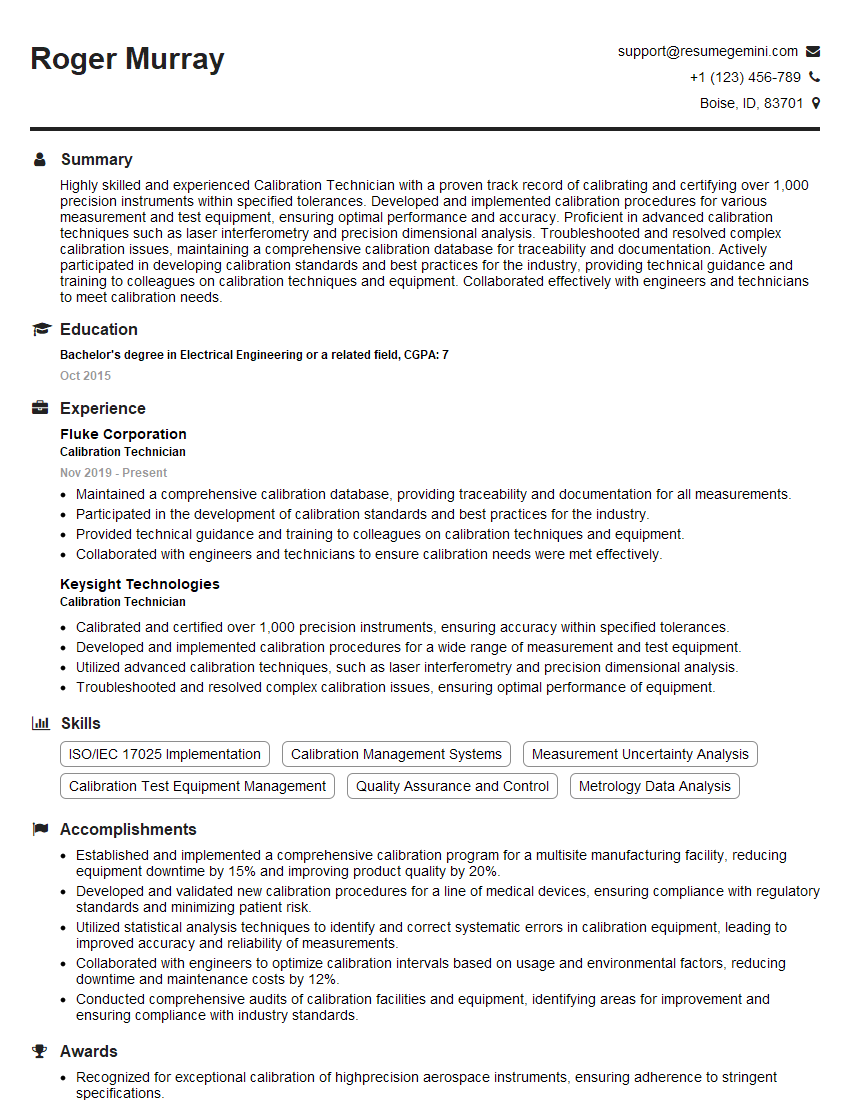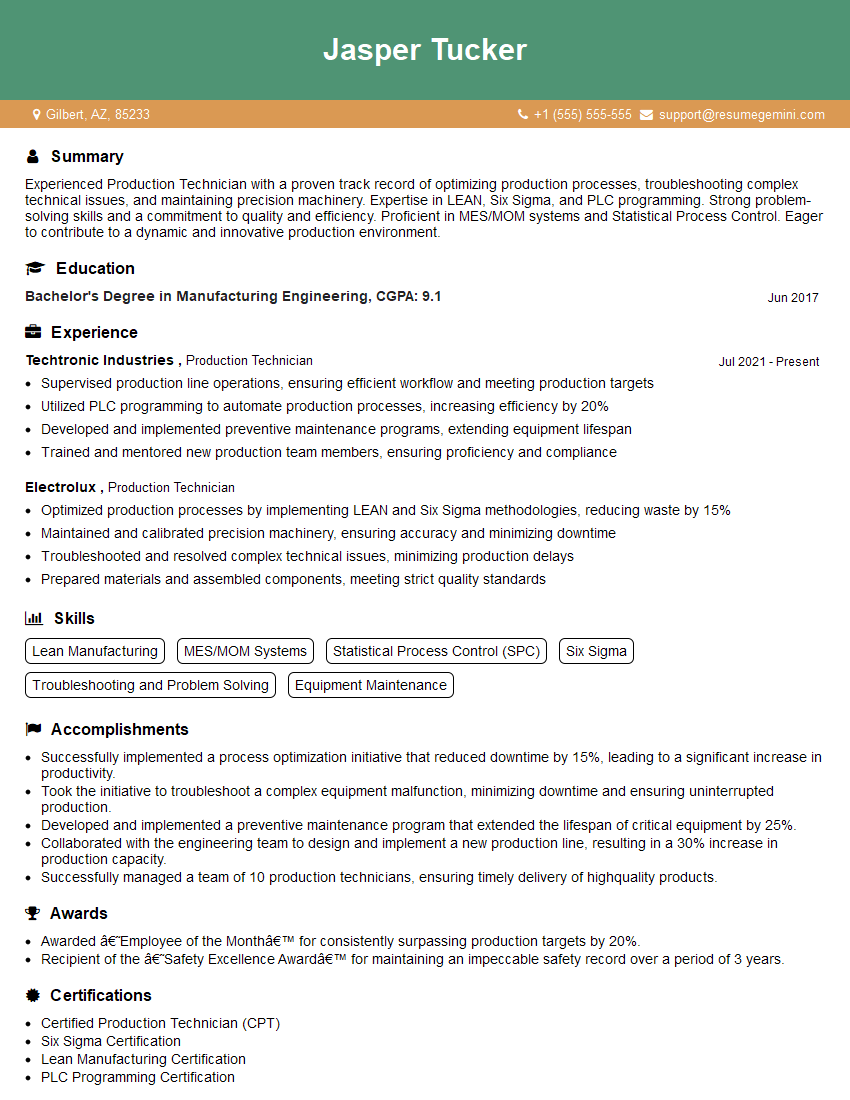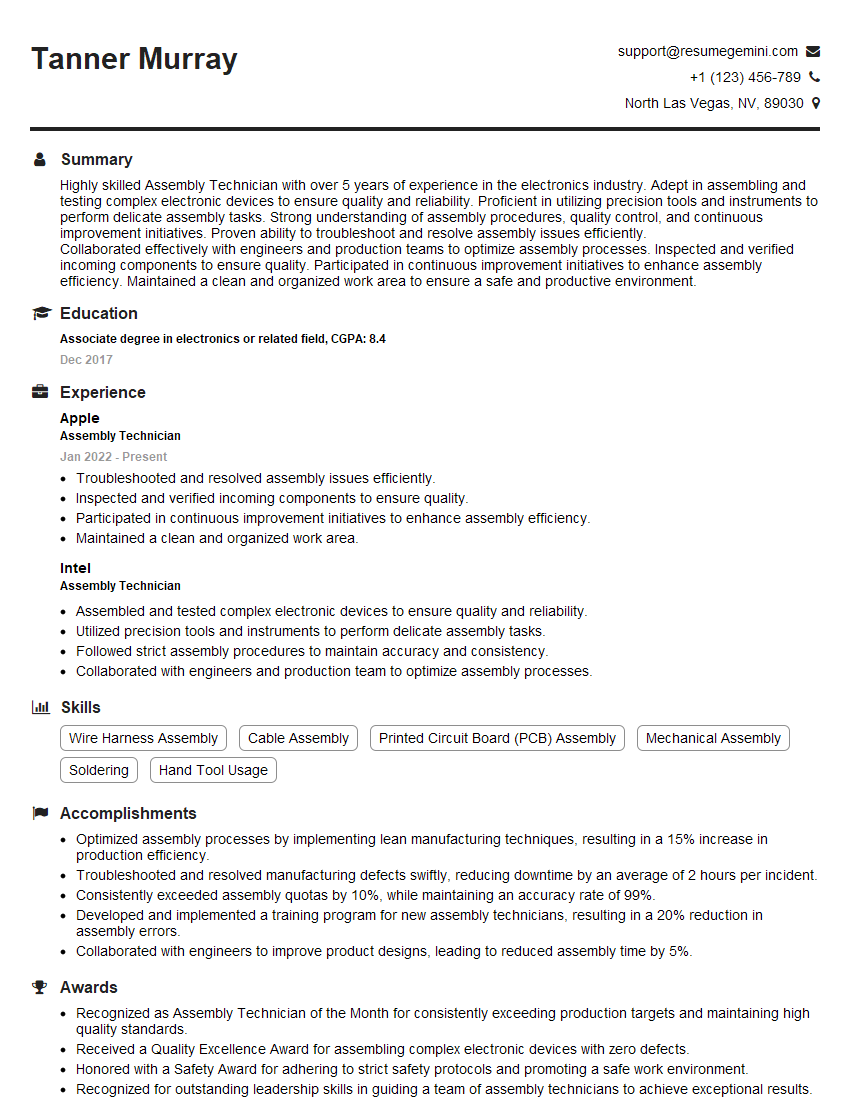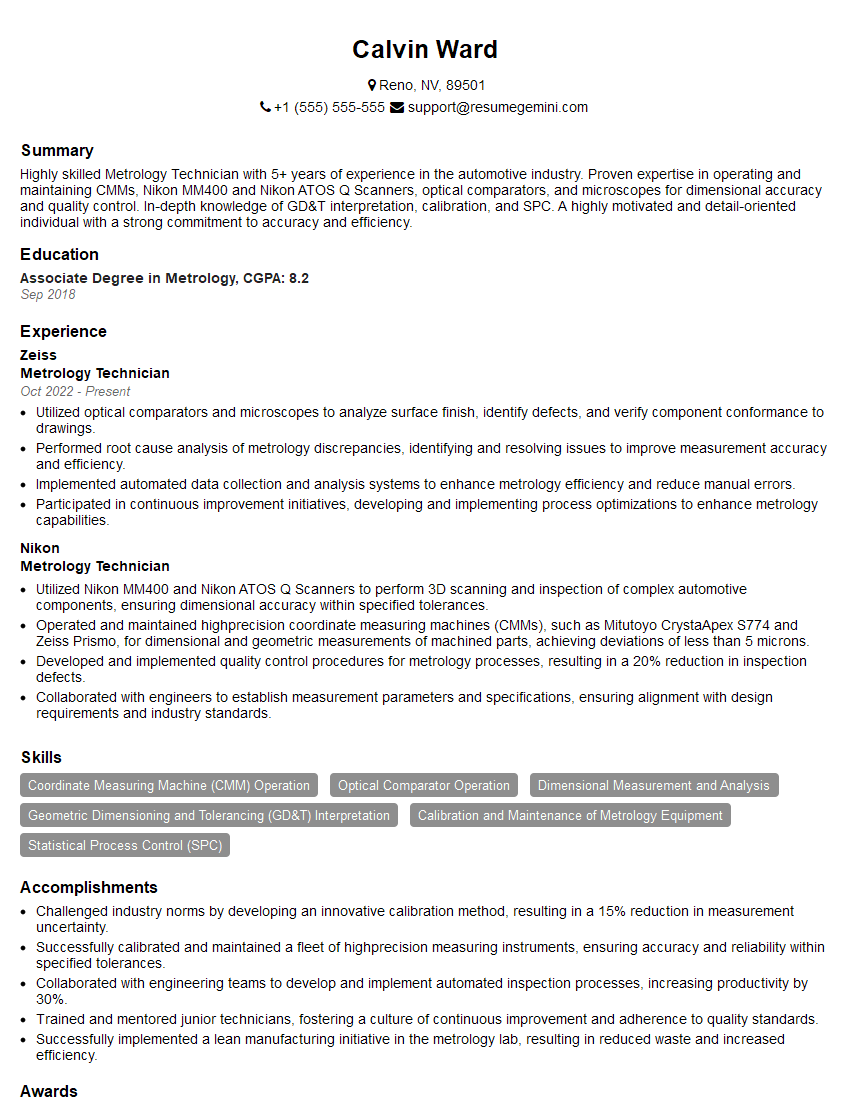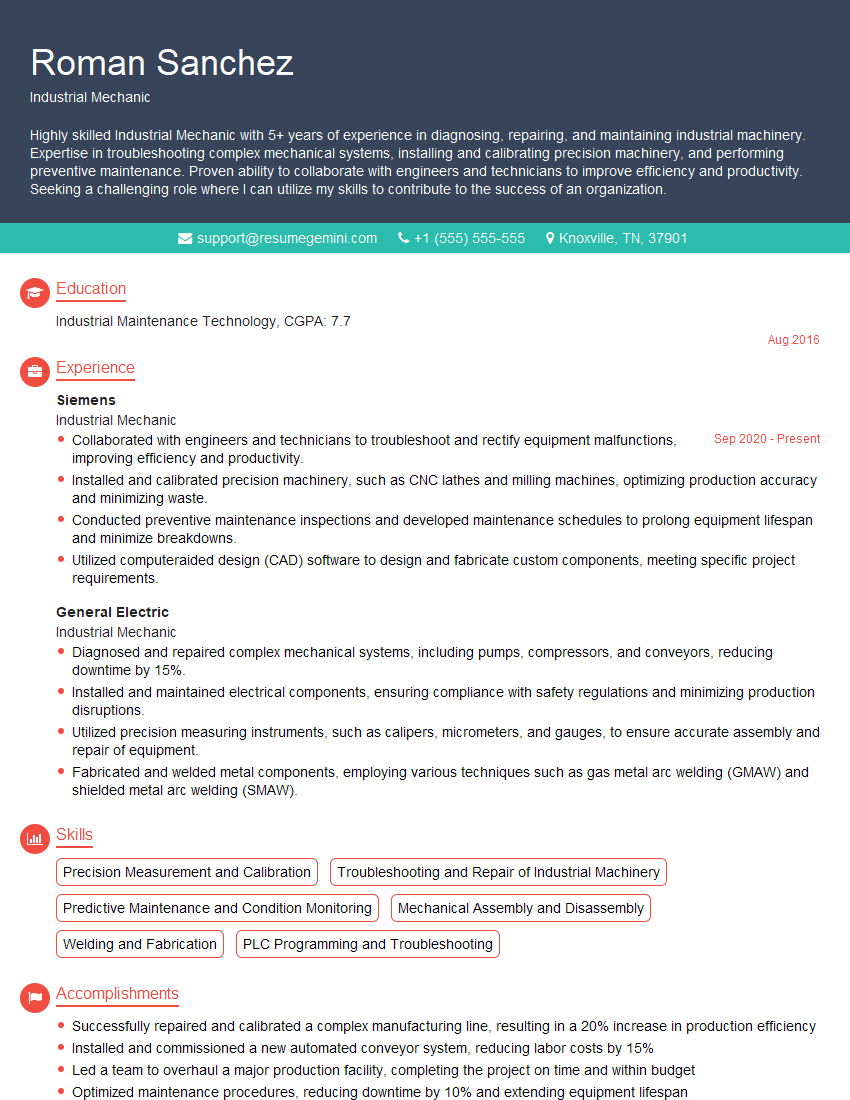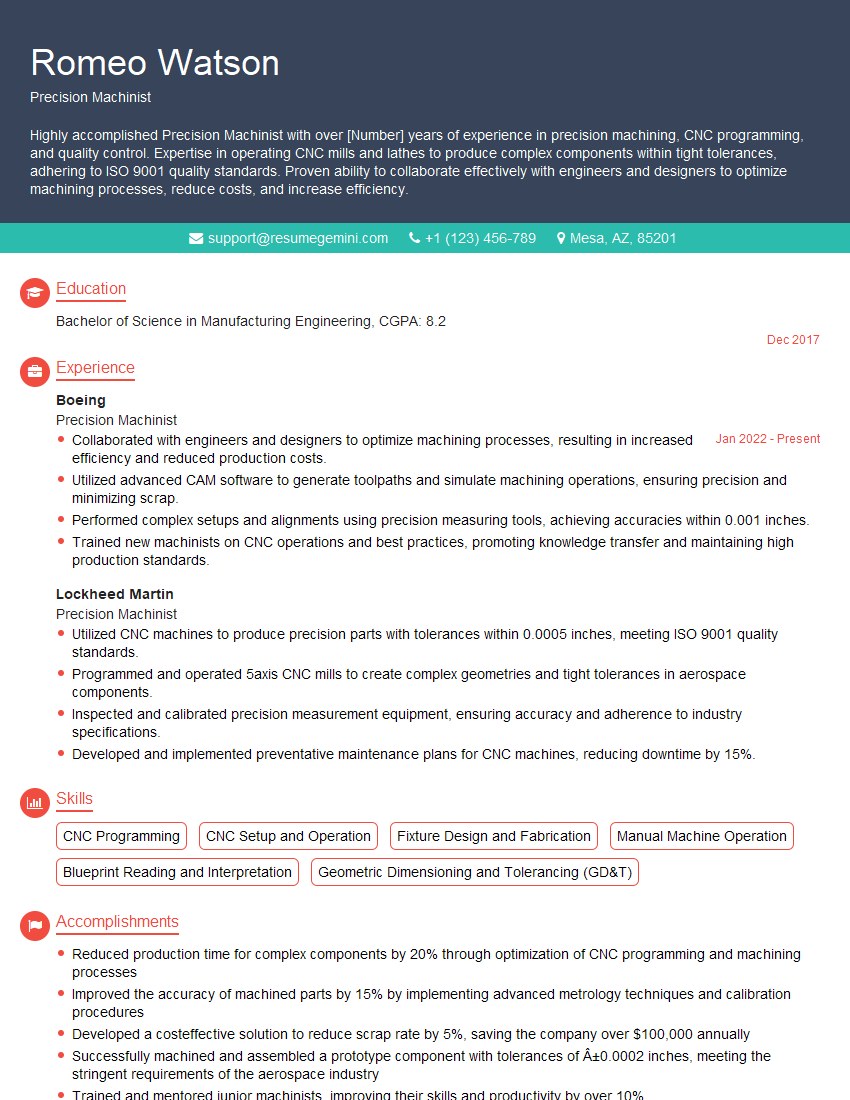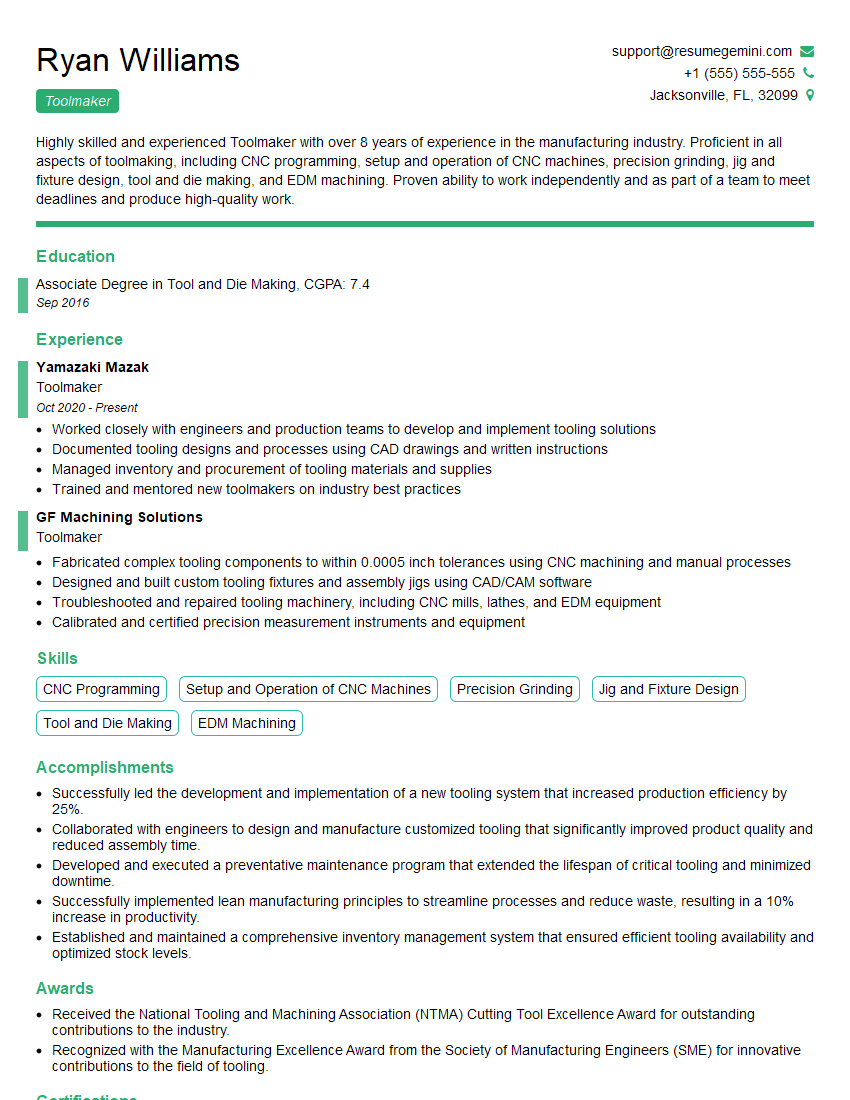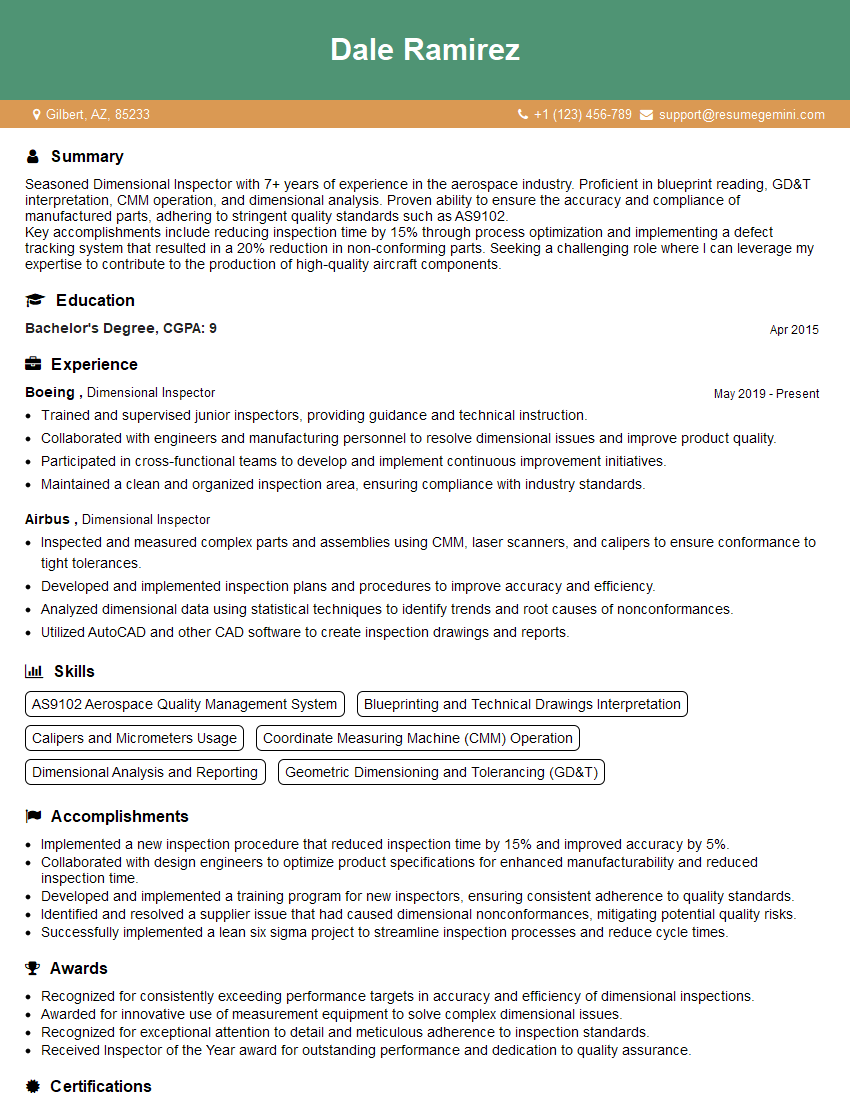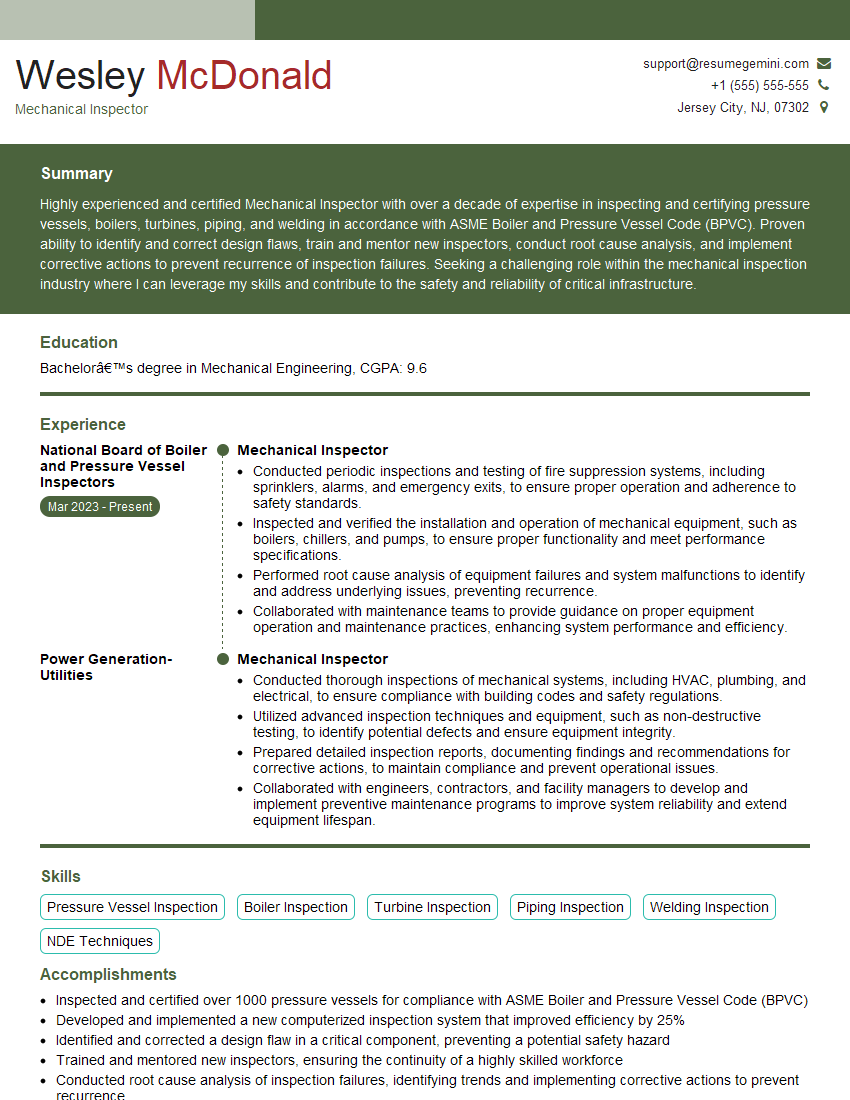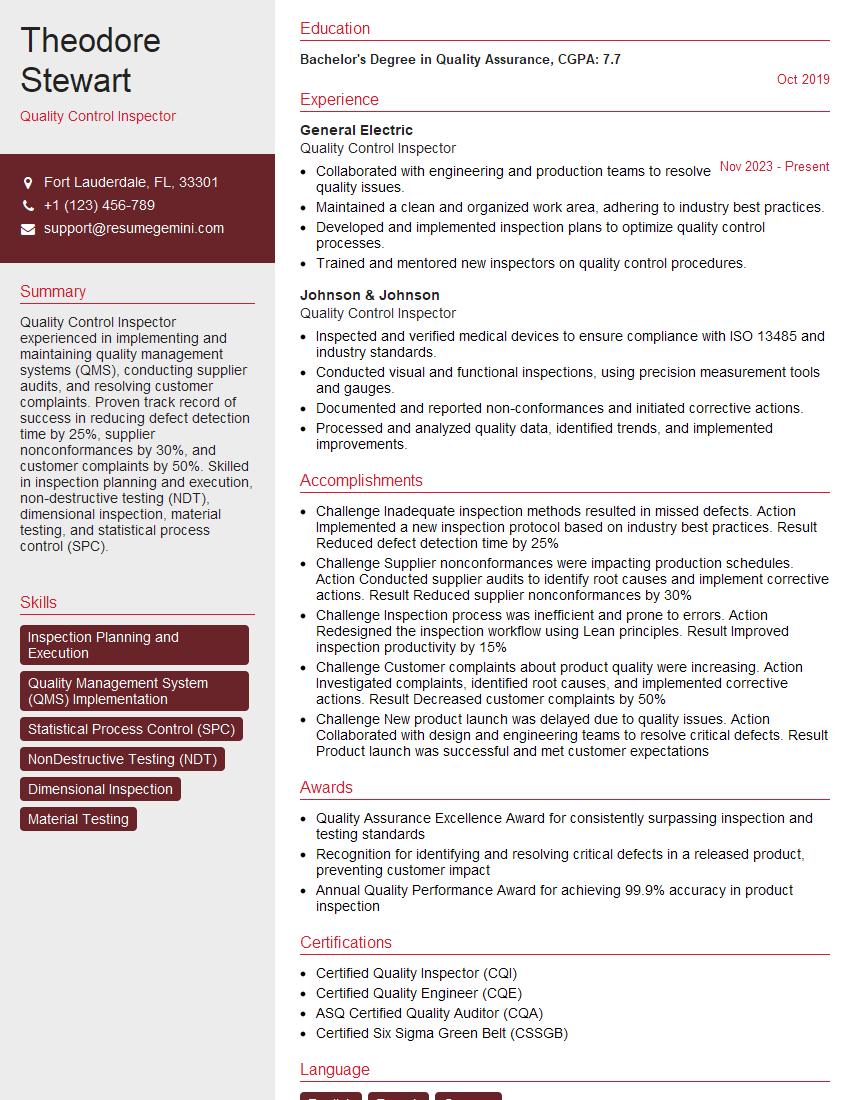Unlock your full potential by mastering the most common Proficiency with Measuring Instruments (e.g., Micrometers, Calipers) interview questions. This blog offers a deep dive into the critical topics, ensuring you’re not only prepared to answer but to excel. With these insights, you’ll approach your interview with clarity and confidence.
Questions Asked in Proficiency with Measuring Instruments (e.g., Micrometers, Calipers) Interview
Q 1. Explain the difference between a vernier caliper and a micrometer.
Both vernier calipers and micrometers are precision measuring instruments used to measure small distances, but they differ in their mechanisms and precision. A vernier caliper uses a sliding vernier scale against a main scale to achieve higher accuracy than a simple ruler. It’s great for measuring external and internal dimensions, depths, and step heights. Think of it like a super-accurate ruler with sliding jaws. A micrometer, on the other hand, employs a rotating thimble with a precisely calibrated screw mechanism. This allows for incredibly precise measurements in increments as small as 0.001 mm or 0.0001 inches. It’s like a tiny, highly accurate screw that measures the distance between its anvil and spindle.
The key difference lies in their precision. Micrometers generally provide much higher resolution (ability to distinguish between small differences) than vernier calipers. A micrometer is better suited for very fine measurements, while a vernier caliper is versatile and suitable for a broader range of applications where slightly less precision is acceptable.
Q 2. How do you determine the zero error of a micrometer?
Determining the zero error of a micrometer involves checking the reading when the anvil and spindle are closed together. Ideally, the reading should be exactly zero. However, due to wear or slight misalignment, a zero error can occur.
To find the zero error:
- Close the micrometer’s anvil and spindle completely.
- Observe the reading on the thimble scale and sleeve scale.
Interpreting the reading:
- Zero error is positive (plus error) if the reading shows a value greater than zero. For example, if the reading is 0.02 mm, there’s a +0.02 mm zero error. This means you need to subtract this value from all measurements taken.
- Zero error is negative (minus error) if the reading shows a value less than zero (it might appear as if the zero line is not exactly aligned). If the reading shows -0.01 mm, this value must be added to all subsequent measurements.
Always note the zero error before any measurement to compensate for it during the reading calculation.
Q 3. What are the common sources of error when using a caliper?
Several factors can introduce errors when using a vernier caliper. These include:
- Parallax error: This occurs when your eye is not directly aligned with the scale markings, leading to inaccurate readings. Always ensure your eye is perpendicular to the scale to avoid this.
- Improper clamping pressure: Applying too much or too little pressure to the jaws can distort the object being measured or affect the accuracy of the reading. A firm but gentle grip is needed.
- Wear and tear: Over time, the jaws of the caliper might become worn, leading to inconsistent measurements. Regular calibration is necessary to maintain accuracy.
- Temperature variations: Changes in temperature can affect the dimensions of both the caliper and the object being measured. This is particularly significant for precision work.
- Zero error: Similar to micrometers, calipers can have a zero error, a reading that’s not zero when the jaws are closed. This needs to be accounted for in your measurements.
- Incorrect reading of the scale: Misinterpretation of the main scale and vernier scale readings can lead to errors. Practice reading the scale accurately.
Q 4. How do you measure the inside diameter of a pipe using a caliper?
Measuring the inside diameter of a pipe with a vernier caliper involves using the caliper’s inside jaws. Here’s how:
- Carefully insert the inside jaws of the caliper into the pipe. Ensure that the jaws are fully seated against the inside walls of the pipe. Avoid applying excessive pressure.
- Gently tighten the caliper’s locking mechanism to hold the jaws in position.
- Remove the caliper from the pipe and carefully read the measurement on both the main scale and vernier scale. Take into consideration any zero error.
- Add the main scale reading and the vernier scale reading to obtain the inside diameter of the pipe.
Example: If the main scale reads 25 mm and the vernier scale reads 0.3 mm, the inside diameter is 25.3 mm. Always remember to account for any zero error.
Q 5. How do you measure the depth of a hole using a micrometer?
Measuring the depth of a hole with a micrometer usually requires a depth micrometer, which has a long spindle designed for this purpose. A standard micrometer is not suitable.
- Insert the spindle of the depth micrometer into the hole until the measuring surface rests on the bottom of the hole.
- Carefully rotate the thimble until a firm contact is made but without applying excessive force. The reading should accurately reflect the hole depth.
- Read the measurement from the sleeve and thimble scales. Remember to account for zero error, if any.
Note: The size of the depth micrometer should be selected to accommodate the depth of the hole. Attempting to measure a deep hole with a short depth micrometer will lead to inaccurate results.
Q 6. What is the least count of a typical micrometer?
The least count of a typical micrometer is 0.01 mm (or 0.001 inch). This means the smallest increment the micrometer can measure is one-hundredth of a millimeter (or one-thousandth of an inch).
Q 7. What is the least count of a typical vernier caliper?
The least count of a typical vernier caliper is 0.02 mm (or 0.001 inch), depending on the model. This indicates that the smallest division the caliper can resolve is 0.02 mm (or 0.001 inch).
Q 8. Explain the process of verifying the accuracy of a micrometer.
Verifying a micrometer’s accuracy is crucial for precise measurements. We typically use gauge blocks (precision-machined blocks of known dimensions) for this purpose. The process involves comparing the micrometer’s readings against the known dimensions of the gauge blocks.
- Select appropriate gauge blocks: Choose gauge blocks whose combined thickness falls within the micrometer’s measuring range. For example, if you’re verifying the accuracy at 10mm, select blocks that add up to 10mm.
- Zero the micrometer: Ensure the micrometer is properly zeroed by closing the anvils and checking for a zero reading. If not, adjust it following manufacturer’s instructions.
- Measure the gauge blocks: Carefully measure the gauge blocks using the micrometer, taking multiple readings (at least three) and recording them. This helps account for slight variations in measurement.
- Compare readings: Compare the average of your micrometer readings to the known combined thickness of the gauge blocks. A small discrepancy is acceptable, falling within the micrometer’s tolerance (specified by the manufacturer). Large deviations indicate the micrometer needs calibration or repair.
- Document findings: Always record your findings, including date, gauge block sizes, micrometer readings, and any discrepancies. This creates a traceable history for quality control.
Think of it like checking a kitchen scale with known weights – if the scale doesn’t show the correct weight, you know there’s a problem.
Q 9. Describe how to measure the thickness of a thin sheet of material.
Measuring the thickness of a thin sheet requires a careful approach, often using a micrometer or a depth micrometer. A stack of multiple sheets can also improve accuracy.
- Stacking Method (for multiple sheets): Accurately stack several identical sheets together to create a combined thickness that is easily measurable with a micrometer. Measure the total thickness, then divide by the number of sheets to find the individual thickness.
- Micrometer Measurement: Use a micrometer, gently clamping the sheet between the anvils. Ensure the sheet is flat and not wrinkled to avoid inaccurate readings. Take several readings from different locations on the sheet to account for any inconsistencies in the material’s thickness.
- Depth Micrometer: For extremely thin sheets, a depth micrometer might be preferable. This allows for precise measurement from a fixed reference point to the surface of the material.
For example, if measuring a thin plastic film, stacking multiple films and then dividing the total thickness by the number of layers ensures a more reliable measurement compared to trying to measure just one sheet directly.
Q 10. How would you measure the diameter of a small ball bearing?
Measuring the diameter of a small ball bearing is best achieved using a micrometer, specifically an outside micrometer. However, you need to ensure the bearing is placed correctly for an accurate measurement.
- Prepare the micrometer: Ensure your micrometer is clean and properly zeroed.
- Position the ball bearing: Carefully place the ball bearing between the micrometer’s anvils. Ensure that the anvils are making contact with opposite sides of the bearing, avoiding any tilting or wobbling.
- Measure the diameter: Gently tighten the micrometer thimble until you feel a slight resistance and then note the reading. Take multiple readings at different orientations, rotating the ball bearing slightly after each measurement, to ensure a mean accurate measurement.
- Record and average readings: Record each measurement and then calculate the average to minimize the effect of small errors.
It’s important to note that the smooth, round surface of the ball bearing makes it less prone to errors compared to measuring irregular shapes.
Q 11. What are the different types of micrometers available?
Micrometers come in various types, each designed for specific applications:
- Outside Micrometer: Used to measure the external dimensions of objects. This is the most common type.
- Inside Micrometer: Measures the internal dimensions of holes or bores.
- Depth Micrometer: Measures the depth of holes or recesses.
- Digital Micrometer: Provides a digital readout, eliminating the need for interpretation of a scale.
- Vernier Micrometer: Offers a slightly higher resolution compared to standard micrometers.
The choice depends on the specific measurement task. For example, an inside micrometer is essential for checking the diameter of a drilled hole, while a depth micrometer is ideal for determining the depth of a threaded hole.
Q 12. What are the different types of calipers available?
Calipers also have several types, each serving a unique purpose:
- Vernier Caliper: A precise measuring instrument using a vernier scale for enhanced accuracy. They come in outside, inside, and depth types, similar to micrometers.
- Digital Caliper: Offers a digital readout for easier and more convenient measurements.
- Dial Caliper: Uses a dial indicator to display measurements. They are often used in situations where a digital readout is not essential.
- Outside Caliper: Measures external dimensions.
- Inside Caliper: Measures internal dimensions.
- Depth Caliper: Measures depths.
Choosing the right caliper type depends on the application. For instance, a digital caliper might be preferred for quick measurements in a production setting, while a vernier caliper might be chosen for higher accuracy where precision is paramount.
Q 13. How do you clean and maintain a micrometer?
Proper cleaning and maintenance are vital for a micrometer’s accuracy and longevity.
- Cleaning: After each use, gently wipe the anvils and spindle with a lint-free cloth. Avoid using abrasive materials or solvents that could damage the surfaces. Compressed air can help remove dust or debris from hard-to-reach areas.
- Lubrication: Apply a small amount of high-quality micrometer oil to the spindle and anvils to ensure smooth operation and prevent wear. Avoid excessive oil, which could attract dirt.
- Storage: Store the micrometer in its protective case to prevent damage and contamination. Keep it in a dry place away from extreme temperatures and humidity.
- Regular Inspection: Periodically inspect the micrometer for any signs of damage or wear to the anvils. If you notice any significant damage, have it professionally calibrated or repaired.
Regular maintenance will help to prolong the lifespan of your micrometer and ensure accurate measurements over time. It’s a small investment that pays off in terms of reliability and precision.
Q 14. How do you clean and maintain a vernier caliper?
Maintaining a vernier caliper is similar to a micrometer, focusing on cleanliness and lubrication for optimal performance.
- Cleaning: Wipe down the caliper with a lint-free cloth after each use to remove any dirt or debris. Pay special attention to the sliding surfaces and jaws. Avoid harsh chemicals or abrasive cleaners.
- Lubrication: Apply a small amount of caliper lubricant to the sliding surfaces to ensure smooth movement. Over-lubrication should be avoided as it can attract dirt and grime.
- Storage: Store the caliper in its case to protect it from damage and prevent it from becoming contaminated. Keep it in a dry and controlled environment away from moisture and extreme temperatures.
- Inspection: Regularly check the caliper for any signs of damage or wear. If you notice any issues with the movement, alignment, or readability of the scales, the caliper should be serviced by a professional.
Like with a micrometer, proper care of your vernier caliper will guarantee its accuracy and prolong its usability for many years.
Q 15. Explain the concept of digital calipers and their advantages.
Digital calipers are a significant advancement in precision measurement. Unlike their analog counterparts, they employ electronic sensors to measure internal, external, and depth dimensions. The data is then displayed digitally on an LCD screen, eliminating the need for visual interpretation of scales and reducing human error.
- Advantages:
- Increased Accuracy: Digital calipers offer higher resolution and repeatability than analog calipers, leading to more precise measurements.
- Faster Readings: The digital display instantly shows the measurement, saving time compared to interpreting analog scales.
- Data Logging Capabilities: Many models allow you to store measurements, making it easier to track progress or for later analysis.
- Multiple Measurement Units: They can typically switch between different units like inches, millimeters, and fractions, catering to various applications.
- Reduced Eyestrain: The clear digital display reduces eyestrain associated with reading small, marked scales on analog calipers.
For example, in a manufacturing setting, digital calipers are essential for quality control. A slight variation in a part’s dimensions can significantly affect its functionality, and the precision of digital calipers ensures that all parts meet the required specifications within a very tight tolerance.
Career Expert Tips:
- Ace those interviews! Prepare effectively by reviewing the Top 50 Most Common Interview Questions on ResumeGemini.
- Navigate your job search with confidence! Explore a wide range of Career Tips on ResumeGemini. Learn about common challenges and recommendations to overcome them.
- Craft the perfect resume! Master the Art of Resume Writing with ResumeGemini’s guide. Showcase your unique qualifications and achievements effectively.
- Don’t miss out on holiday savings! Build your dream resume with ResumeGemini’s ATS optimized templates.
Q 16. Describe the use of a dial indicator.
A dial indicator, also known as a dial gauge, is a precision measuring instrument used to check the deviation from a reference point or surface. It consists of a dial with a pointer that moves in response to a probe’s displacement. The dial displays measurements in increments as small as 0.001 inches or 0.01 millimeters, depending on the model. These instruments are very sensitive to even slight changes in position.
Use Cases:
- Measuring runout or concentricity: Checking if a cylindrical object rotates perfectly around its central axis.
- Checking flatness: Determining the deviation from a perfectly flat surface.
- Measuring depth or height: With an appropriate attachment, a dial indicator can measure depth or height differences.
- Alignment checks: Ensuring two surfaces are precisely aligned.
- Machine set-up: Precise adjustment of machine components during setup.
Imagine you’re setting up a lathe. Using a dial indicator attached to the machine’s bed, you can precisely align the workpiece, ensuring accurate and consistent cuts. The dial indicator’s sensitivity helps you achieve the necessary precision for high-quality machining operations.
Q 17. What is the significance of proper calibration in measurement?
Proper calibration is crucial for accurate measurements and is paramount to ensuring reliability in results. A calibrated instrument is verified against a known standard to ensure its readings are within an acceptable range of accuracy. If not calibrated regularly, instruments can drift, leading to inconsistent and potentially unsafe results. This is especially vital for instruments used in quality control and manufacturing where even small errors can have significant impact.
Consider a micrometer used to measure the thickness of a thin metal sheet. If the micrometer hasn’t been calibrated, the readings could be off by a few thousandths of an inch, which is a critical error in manufacturing situations. This might result in rejected parts, costly rework, or even equipment malfunction.
Calibration intervals depend on the instrument’s type, usage frequency, and the level of precision required. It’s important to always adhere to the manufacturer’s recommendations and to maintain detailed calibration records. Using uncalibrated instruments is unacceptable in professional environments.
Q 18. How do you handle worn or damaged measuring instruments?
Worn or damaged measuring instruments should never be used. They can lead to inaccurate readings and compromise the quality of work. The immediate action is to remove them from service. Depending on the nature of the damage, they may be repairable. However, it’s critical to consult with experienced professionals or a metrology lab to assess the damage and determine if repair is feasible. Minor damages, like scratches on a caliper’s jaws, might be manageable, but significant damage, such as a bent measuring arm on a micrometer, usually necessitates replacement.
Using a worn instrument is akin to relying on a damaged ruler: you wouldn’t trust it to make precise measurements. The consequences could range from minor inconveniences to catastrophic failures. Prevention is key; regular inspection and proper handling of measuring instruments are crucial in extending their lifespan and preventing premature wear and tear. Proper storage in a case or protective container is also essential.
Q 19. How do you record measurements accurately and legibly?
Accurate and legible recording of measurements is essential for traceability and repeatability. Here’s how to accomplish this:
- Use a Consistent Format: Choose a standard unit of measurement (e.g., millimeters) and stick to it throughout the recording process.
- Be Precise: Record measurements to the instrument’s resolution. For instance, if your caliper has a resolution of 0.01 mm, record your measurement to two decimal places (e.g., 25.32 mm).
- Clearly Identify Units: Always indicate the units of measurement (mm, inches, etc.) next to the numerical value.
- Write Legibly: Write clearly and avoid ambiguities to prevent misinterpretations.
- Note Any Observations: If you observe anything unusual during the measurement process (e.g., a slightly bent part), make a note of it.
- Use Tables or Spreadsheets: For multiple measurements, use tables or spreadsheets to organize the data effectively.
For instance, instead of scribbling ‘25mm,’ write ‘25.00mm’ and then clearly state which dimension you are recording, like ‘Length = 25.00mm.’ Proper record-keeping is crucial to maintain the integrity of data.
Q 20. Explain the importance of using the correct measuring instrument for a specific task.
Using the correct measuring instrument is paramount for obtaining accurate and reliable results. Each instrument is designed for specific applications and possesses a particular range of accuracy and resolution. Using an inappropriate instrument can lead to significant errors.
For example, using a ruler to measure the diameter of a small ball bearing is unsuitable; the ruler’s limited resolution will provide inaccurate readings. Instead, a micrometer or vernier caliper would be appropriate for a precise measurement of the bearing’s diameter. Conversely, using a micrometer for measuring large distances would be inefficient and impractical. Using the correct instrument guarantees the right measurement and the necessary accuracy for the given task. Employing the wrong tool wastes time and compromises quality.
Q 21. How do you select the appropriate measuring instrument for a given application?
Selecting the appropriate measuring instrument involves considering several factors:
- Accuracy Required: What level of precision is needed? A higher accuracy demand requires a more sophisticated instrument.
- Range of Measurement: What is the size or dimension range to be measured?
- Type of Measurement: Are you measuring internal, external, or depth dimensions? Are you measuring linear, angular, or other dimensions?
- Material of the object: The material’s properties might influence the selection.
- Cost and Availability: Budget constraints and available instruments.
For instance, if you need to measure the thickness of a very thin wire with high precision, you would choose a digital micrometer with a fine resolution. For rough measurements of larger objects, a simple ruler might suffice. The goal is to match the instrument’s capabilities with the specific requirements of the application.
Q 22. Describe a time you had to troubleshoot a problem related to a measurement discrepancy.
During a critical phase of a project involving the manufacturing of precision engine components, we encountered a significant discrepancy in the measurements of a crucial shaft diameter. Initial measurements using a digital caliper indicated a dimension consistently 0.02mm smaller than the CAD specifications. This was unacceptable as it could lead to engine malfunction.
My troubleshooting involved a systematic approach. First, I verified the caliper’s calibration using a certified gauge block. The caliper was within its tolerance range, eliminating it as the source of error. Next, I examined the measurement technique – ensuring proper anvil contact and avoiding parallax errors. I then checked the workpiece itself for any surface imperfections or inconsistencies that might be affecting the measurement. I discovered that the slight discrepancy was caused by a build-up of microscopic metal shavings on the shaft’s surface, which was interfering with the caliper’s accuracy. Thorough cleaning of the shaft with a suitable solvent resolved the issue. The measurements then aligned perfectly with the design specifications, averting a potential production delay and ensuring product quality.
Q 23. What is your experience with different measurement units (e.g., inches, millimeters)?
I’m highly proficient in both metric (millimeters, centimeters, meters) and imperial (inches, feet) measurement units. My experience spans various applications, from using micrometers to measure the thickness of thin gauge materials in millimeters to using calipers to measure the dimensions of larger components in inches. I’m comfortable converting between units and selecting the appropriate unit system based on the project requirements and international standards (e.g., ISO). I’ve worked extensively with both systems across different projects and can seamlessly switch between them as needed, ensuring accuracy and avoiding costly errors.
Q 24. How familiar are you with different types of scales (e.g., metric, imperial)?
I have a deep understanding of both metric and imperial scales. My experience encompasses precise measurements in both systems, including their respective units and conversion factors. The selection of the appropriate scale is often dictated by industry standards, client specifications, and the tools available. For example, while the automotive industry heavily utilizes the metric system, certain legacy machinery may still operate using the imperial system. Understanding both systems is crucial for effective collaboration across diverse teams and manufacturing environments. My expertise lies in ensuring seamless transitions and accurate conversions between systems to avoid confusion and errors.
Q 25. Describe your experience using specialized measuring tools such as optical comparators.
I have significant experience using optical comparators for precise dimensional inspections and quality control. This equipment allows for high-magnification analysis of parts, particularly intricate geometries and surface features. In past projects, I’ve utilized optical comparators to verify the accuracy of manufactured parts against their engineering drawings, often detecting minute variations that would be impossible to observe with conventional measuring tools. My expertise extends to interpreting the projected image, using various lenses and magnification levels, and accurately reporting findings. This includes identifying deviations from specifications, such as dimensional inaccuracies, surface imperfections, and alignment errors. Optical comparators are invaluable tools for ensuring the highest levels of quality control, especially in applications requiring very tight tolerances.
Q 26. How do you ensure the safety of yourself and others when using measuring instruments?
Safety is paramount when handling measuring instruments. My approach is based on a three-pronged strategy: proper training, diligent maintenance, and adherence to safety protocols. Before using any instrument, I always ensure I’m thoroughly familiar with its operation and safety guidelines. This includes understanding the potential hazards and implementing the necessary precautions. Regular maintenance, such as checking for damage and ensuring calibration, is essential to prevent accidents caused by faulty instruments. Furthermore, I maintain a clean and organized workspace, avoiding clutter that could lead to injuries or instrument damage. In a team setting, I actively contribute to a culture of safety by promoting best practices and addressing any unsafe behaviors.
Q 27. What are some common safety precautions when using micrometers and calipers?
When using micrometers and calipers, safety involves several key precautions. Always handle these precision instruments carefully, avoiding dropping or impacting them. Use a clean cloth to remove dirt or debris from the measuring surfaces to maintain accuracy and prevent damage. Ensure proper anvil and spindle alignment to avoid inaccurate readings. Never exert excessive force during measurement to prevent damage to both the instrument and the workpiece. Always store instruments in protective cases to prevent damage and maintain calibration. Regular calibration and maintenance are crucial for accuracy and user safety.
Q 28. Explain your understanding of tolerance and its importance in precision manufacturing.
Tolerance in precision manufacturing refers to the permissible variation from a specified dimension or characteristic. It defines the acceptable range within which a measurement can fall without being considered defective. For example, a shaft specified as 10.00mm +/- 0.01mm means the acceptable diameter range is between 9.99mm and 10.01mm. Tolerance is crucial because it ensures that manufactured parts fit together correctly and function as intended. Tight tolerances are essential for critical applications requiring high precision, such as aerospace or medical device manufacturing. Understanding tolerance specifications is critical for selecting appropriate measuring instruments and ensuring quality control throughout the manufacturing process. Failure to meet tolerance specifications can lead to part rejection, assembly issues, and potentially product failure.
Key Topics to Learn for Proficiency with Measuring Instruments (e.g., Micrometers, Calipers) Interview
- Understanding Measurement Principles: Grasping the fundamental principles of precision measurement, including accuracy, precision, tolerance, and error analysis.
- Micrometer Operation and Calibration: Mastering the proper techniques for using a micrometer, including zeroing, reading thimbles, and understanding vernier scales. Know how to calibrate and verify the accuracy of the instrument.
- Caliper Operation and Calibration: Becoming proficient in using various types of calipers (e.g., vernier, digital) and understanding their limitations. Learn how to correctly measure internal, external, and depth dimensions.
- Selecting the Right Instrument: Understanding the appropriate instrument to use for different measurement tasks based on accuracy requirements and part geometry.
- Practical Applications: Being able to describe real-world scenarios where precise measurement using micrometers and calipers is crucial (e.g., quality control, manufacturing, machining).
- Troubleshooting Measurement Issues: Knowing how to identify and address common problems encountered during measurements, such as parallax error or instrument malfunction.
- Data Recording and Interpretation: Understanding the importance of accurately recording measurements and interpreting the data to draw meaningful conclusions.
- Safety Procedures: Familiarize yourself with safe handling and maintenance practices for measuring instruments.
- Different Units of Measurement: Be comfortable converting between different units (e.g., inches, millimeters).
Next Steps
Mastering proficiency with measuring instruments like micrometers and calipers is crucial for career advancement in many technical fields. It demonstrates attention to detail, precision, and a strong understanding of fundamental engineering principles. To significantly boost your job prospects, create a compelling and ATS-friendly resume that highlights your skills and experience. ResumeGemini is a trusted resource to help you build a professional and effective resume that showcases your expertise. We offer examples of resumes tailored to roles requiring proficiency with measuring instruments, providing you with a template for success.
Explore more articles
Users Rating of Our Blogs
Share Your Experience
We value your feedback! Please rate our content and share your thoughts (optional).
What Readers Say About Our Blog
Hi, I represent an SEO company that specialises in getting you AI citations and higher rankings on Google. I’d like to offer you a 100% free SEO audit for your website. Would you be interested?
good
